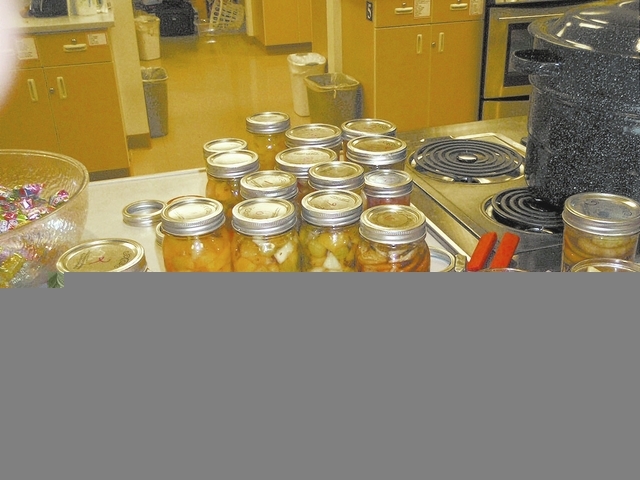Area weather sours ability to grow sweet cherries
Q: I heard about a cherry tree from the Dave Wilson Nursery website that has very low chill hours. Can we order these from the University of Nevada Cooperative Extension Master Gardener Orchard?
A: There are low-chill sweet cherries but they have been in such high demand we have not been able to secure any in past years.
However, we have had no problems growing high-chill-hour apples, peaches, apricots and plums in the valley. They have been productive for more than 15 years. So the idea of chilling hours being an “on or off switch” for producing fruit should not always be a consideration when selecting varieties.
Sweet cherries are a problem in Southern Nevada unless you can plant them in a backyard where they have protection from wind and there is some humidity from a pool or lawn. We had many varieties of sweet cherries and produced only about 12 cherries from all of them in 15 years at the UNCE orchard in North Las Vegas.
Sweet cherries flower extremely well so chilling has not been the problem. The problem has been in setting the fruit and keeping it on the tree. Poor flowering is what you would expect if you didn’t have enough chill hours.
Other people in town have had success with sweet cherries but nearly all of them appear to be in backyards that are protected and have a higher humidity. The people in Las Vegas who have been growing sweet cherries successfully tell me that they have grown Bing, Lambert and other common varieties.
You might have more luck with sour cherries; they are more versatile anyway. We have no reports to give you yet whether they will work here or not because they are still being tested.
Q: We have had several trees die during the past year so we are looking for replacements that will do well here. We have a Kiefer pear that produces really small, rock-hard pears that never seem to ripen. Can you give us some suggestions please for almond, nectarine, pluot and apricot.
A: If I were to plant only one almond tree, it would be Garden Prince. It is smaller than the other almond varieties and the flower is a beautiful purplish white instead of plain white. For a home landscape that needs a smaller-sized tree, beautiful flowers and wonderful nuts, Garden Prince can’t be beat. It is self-pollinating so it doesn’t need a second almond for pollination.
Arctic Star nectarine has a remarkable flavor in our climate. It is floral, buttery and one of the best fruits I have ever tasted. It makes wonderful sorbet. But you must remember that you will have problems with thrips that will result in horrible scarring of the fruit if you don’t keep it under control. It must be sprayed.
Remember that pluots require a pollinator tree for improved fruit set. A good pollinator for pluot also is a great plum for our area; it is called Santa Rosa. If you already have a Santa Rosa plum or your neighbor does, you don’t need a pollinator tree for pluot.
Among the pluots, the best tasting in my opinion is Flavor Supreme. Second on my list would be Flavor King. The problem we have had with Flavor Supreme is low fruit production, even with a pollinator. Flavor King has such a large fruit set, it must be thinned.
The second problem with all pluots is late spring freezes in the developmental fringes of our valley, which are typically colder.
When we get a freeze and they are in flower, you probably will not get any fruit that year. So expect fruit in two or three years out of every five if you live in these colder areas of the valley.
A great apricot, that is not really an apricot but a cross between an apricot and plum, is the aprium. The fruit looks identical to and is marketed commercially as an apricot. It has flavor attributes of plum and apricot in the fruit. The best aprium out there is called Flavor Delight, which will be available from the UNCE orchard.
Your Kiefer pear is different from pears such as Bartlett or d’Anjou, which are dessert pears. Dessert pears will get soft and buttery in texture if you harvest them slightly early and let them ripen at room temperature. Kiefer pear is a salad pear that also is great for canning and used in stuffing for fowl.
Kiefer pear should be harvested just as you would a dessert pear. To judge when to harvest I use a change in color of the fruit and smell. The fruit color will change from green to yellowish green and you will detect a distinct pear aroma from the fruit. They will still be hard when harvested.
You also can sacrifice a fruit and cut it open and check the color of the seeds. They should be dark brown when the fruit is ready. But if you compare a Kiefer pear with a dessert pear, you will be very disappointed. They are both great, but in different ways.
Would you like to put up canned vegetables or fruit that you have grown in your garden or meat that you have purchased on sale? The Cooperative Extension is again offering classes on becoming a master food preserver, but this time they will be in Logandale.
The master food preserver class is being offered from 9 a.m. to 5 p.m. Nov. 8 and 9 at the Cooperative Extension office in Logandale. The registration fee of $120 covers canning supplies, learning materials such as binders and manuals, and training by Utah State University Extension faculty.
Class size is limited. For more information, email Lori Leas at leasl@unce.unr.edu or call 702-397-2604.
Bob Morris is a horticulture expert living in Las Vegas and professor emeritus for the University of Nevada. Visit his blog at xtremehorticulture.blogspot.com.






















